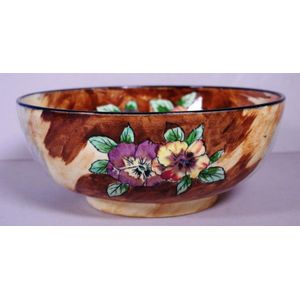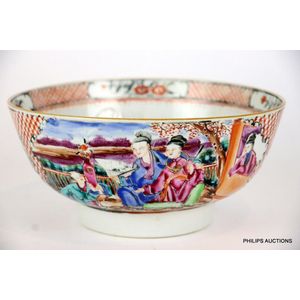18th Century Qing Dynasty Famille Rose Bowl
You must be a subscriber, and be logged in to view price and dealer details.
Subscribe Now to view actual auction price for this item
When you subscribe, you have the option of setting the currency in which to display prices to $Au, $US, $NZ or Stg.
- Mandarin Palette - The Mandarin palette is a decorative style used to decorate Chinese export porcelain, which was produced in China specifically for export to Europe and other parts of the world from the 16th to the 19th century. The Mandarin palette is characterized by a bright and colourful design featuring various figures, landscapes, and ornamental motifs.
The Mandarin palette was first used during the reign of the Kangxi Emperor (1662-1722) in the Qing dynasty. It was named after the Mandarin officials who were depicted in the designs, wearing their distinctive robes and hats. The palette was popular among European collectors and was often used to decorate tea services, vases, and other decorative objects.
The Mandarin palette was made up of a limited number of colours, typically blue, green, pink, and gold. The designs often featured figures in a garden setting, surrounded by trees, rocks, and pavilions. Some of the most popular motifs included dragons, birds, flowers, and auspicious symbols, such as bats and peaches.
The Mandarin palette remained popular throughout the Qing dynasty and was used to decorate a wide range of Chinese export porcelain. It continued to be popular among European collectors into the 19th century, and its influence can be seen in the work of many European ceramic artists of the time. - Diaper Motif - The diaper motif is a repeating geometric pattern in decorative arts that consists of small diamond or lozenge shapes arranged in a grid. The pattern is often used as a background or border on textiles, ceramics, metalwork, and other decorative items. It can be found in a variety of cultures and historical periods, and is often used in formal or ornamental designs. The name "diaper" comes from the pattern's resemblance to the criss-crossed fabric of a baby's diaper.
- Qing Dynasty - The Qing Dynasty was the last imperial dynasty of China, ruling from 1644 to 1912. It was established by the Manchu people, who originated from the northeastern region of China. The Qing Dynasty was preceded by the Ming Dynasty and followed by the Republic of China.
- Ming Dynasty - The Ming Dynasty was a ruling dynasty of China from 1368 to 1644. It succeeded the Yuan Dynasty and preceded the Qing Dynasty. The Ming Dynasty was established by Zhu Yuanzhang, a former Buddhist monk who became a rebel leader and eventually overthrew the Mongol Yuan Dynasty. During the Ming Dynasty, China experienced a period of relative stability and prosperity. The government was centralized and bureaucratic, with the emperor at the top of the hierarchy. The Ming Dynasty is known for its cultural achievements, including the development of porcelain, the invention of movable type printing, and the construction of the Great Wall of China.
This item has been included into following indexes:
Visually similar items

Chinese cloisonne fruit bowl, decorated throughout with fruits, bats and clouds, height 14 cm diameter 31.5 cm

Good Chinese bowl with enamelled decoration with flowers on red ground. Signed to base.

Vintage Tunstall 'Viola' bowl, height 9 cm Diameter 22.5 cm

A very unusual Fukagawa-type bowl, Meiji period (1868-1912). Very finely painted with fruiting branches on the exterior in Kakiemon-style enamels, the interior with prunus petals floating on water, in cobalt blue and iron-red, 6.5 cm X13.3 cm. Provenance:
